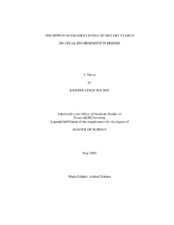The Effect of Graded Levels of Dietary Starch on Cecal Environment in Horses
Abstract
Eight cecally fistulated geldings were used in a randomized 4 x 4 Latin square design to observe the effect varying levels of dietary starch had on cecal environment. The 4 treatment rations contained 2 g starch/kg BW (Diet 2), 4 g/kg BW (Diet 4), 6 g/kg BW (Diet 6), or 8 g/kg BW (Diet 8). The rations were comprised of a commercial pelleted feed to meet 2 g starch/kg BW in each treatment, with ground corn used to fulfill the remaining starch requirements in each diet. Soybean meal was added to ensure diets were iso-nitrogenous, and cottonseed hulls were used to equalize dry matter intake. A 21 day adaptation period was allowed before cecal contents were sampled. Samples were drawn 4 hours after the morning meal and were immediately tested for pH. Samples were used to count total anaerobic bacteria and lactic acid bacteria, as well as determine methane activity, ammonia activity, volatile fatty acids, and in vitro dry matter digestibility (IVDMD). Stoichiometric calculations were performed to give an indirect measure of fermented hexose, methane, and carbon dioxide. Diet did not influence dry matter intake (DMI), however it did have an effect on starch intake (P < 0.0001) and caused a linear increase in starch consumption as the amount of offered starch increased (P < 0.0001). Diet did not influence the pH of the cecum (P > 0.05), although a tendency for a linear decrease (P < 0.06) in pH from 6.92 ? 6.58 occurred when dietary starch increased. Total anaerobic bacteria and lactic acid bacteria were unaffected by treatment diets (P > 0.05). Propionate production was affected by dietary treatment (P < 0.05), causing a quadratic increase (P = 0.04) from 8.26 to 14.13 mM as starch in the diets increased. Diet did not affect the production of acetate, butyrate, or ammonia (P > 0.05). Results found that stoichiometric calculations and IVDMD values were not affected by diet (P > 0.05). These results show that starch intake influenced the production of fermentative by-products, which caused decreases in pH, although there was no observed increase in the bacterial populations of the cecum.
Citation
Wilson, Kristen L. (2009). The Effect of Graded Levels of Dietary Starch on Cecal Environment in Horses. Master's thesis, Texas A&M University. Available electronically from https : / /hdl .handle .net /1969 .1 /ETD -TAMU -2009 -05 -492.


